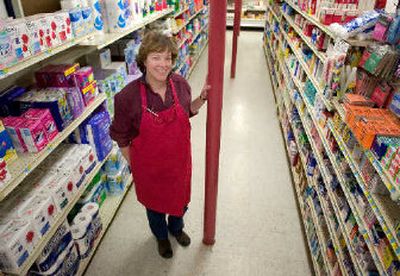Grocery cooperatives help keep small towns alive

ANITA, Iowa — The grocery stores that lined Main Street were always key to the little farm town of Anita, Iowa.
At one time, four groceries met the needs of the large families who lived in the town and surrounding areas.
Maxine Christensen recalls the horses that farmers once hitched behind her family’s general store.
“Grocery stores were a staple of town,” said the 85-year-old Christensen.
Times have changed as Anita’s population dwindled and larger competitors arrived, but the final market remained so important that its pending closure spurred residents to buy shares and create a grocery cooperative.
Co-ops are old hat for most Midwest farmers, but experts believe only a dozen or so across the nation have been created to hang onto community groceries. It’s a move some think will spread to other rural areas beset by similar problems, but they caution that such efforts carry risk.
In Anita, townspeople felt they had no choice — loss of the 90-year-old Main Street Market would mean a virtual end to downtown traffic and trouble for the businesses that remained. And residents wondered what would become of their town without a gathering spot.
“I know quite a few people in town really just because of the store,” said Don Norris, 40, who buys all his meat at the market.
In creating the Anita Grocery Cooperative, residents formed a board and sold about 300 shares at $200 a piece. The co-op board also took out $150,000 in public and private loans.
On Dec. 1, the market opened its doors under new ownership.
Although most residents could have managed the inconvenience of a longer drive for groceries in the regional city of Atlantic, rural towns lose something when fixtures such as a grocery store close. A domino effect kicks in and other businesses begin closing, said Kimberley Zeuli, who studies rural cooperatives and is a visiting professor of economics at The College of William & Mary in Williamsburg, Va.
“At some point, it’s no longer a town,” Zeuli said. “It’s just a gas station.”
Townspeople understand this shift and often try to fight it, frequently by embracing the very chain competitors who put Main Street shops out of business. But many communities can’t entice a Wal-Mart or Target, and in the past decade more have turned to innovative approaches such as co-ops, Zeuli said.
Of the roughly 300 food-store cooperatives nationwide, 5 percent or less are conventional grocery stores, said Stuart Reid, a food co-op development specialist with Food Co-op 500. The private organization grants money to cooperatives through sponsors such as the National Cooperative Bank.
Most of the grocery co-ops are in the Upper Midwest, including Fontanelle, Iowa, Houston, Minn., and Iron River, Wis. The Scottsbluff, Neb.-based Panhandle Cooperative System runs two conventional grocery stores — in Scottsbluff and Torrington, Wyo. — and plans to open a third in February in Wellington, Colo.
Even large retailers are facing more competitors as convenience stores, discounters such as Aldi and drug stores try to grab a share of the $500 billion a year grocery industry, said Bill Greer, a spokesman for the Washington-based Food Marketing Institute, which represents chain stores as well as independent markets.
“All companies are really in the same competitive situation, no matter whether they’re from a large chain or mid-size,” Greer said. “Who’s not going to be in the food business is the question as the industry continues to evolve.”